Beautiful Arizona is filled with red rock deserts, sweeping plateaus, and rugged mountains. It’s also filled with national parks and monuments, including Canyon de Chelly, the Grand Canyon, and the Casa Grande Ruins.
In other words, residents and visitors are spoiled when it comes to bird-watching spots. You can see the state’s 13 resident owls during most parts of the years. Some birds, like the Whiskered screech owl, are rare and will take some dedication to find. Others, like the Great horned owl, are easy to see
Whether you’re in the Dark Sky certified Kaibab Paiute Indian Reservation or right in the heart of Phoenix, and whether you’re hunting during the day or in the dark of night, there are definitely at least a few owl species nearby.
Here is the list of owls in Arizona:
- Great Horned Owl
- Northern Saw-Whet Owl
- Barn Owl
- Western Screech Owl
- Northern Pygmy-Owl
- Ferruginous Pygmy-Owl
- Burrowing Owl
- Flammulated Owl
- Spotted Owl
- Elf Owl
- Whiskered Screech Owl
- Long-Eared Owl
- Short-Eared Owl
13 Types of Owls in Arizona
1. Great Horned Owl

- Scientific name: Bubo virginianus
- Size: 20 inches long
- Weight: 32-88 ounces
- Wingspan: 40-57 inches
Most people recognize the great horned owl thanks to its appearance in movies like the Harry Potter franchise and its characteristic hoot. These massive owls can weigh up to five-and-a-half pounds. They have massive claws, and they’re strong fliers, which enables them to take down fierce prey like ospreys and falcons.
Once they clench their claws around something, it takes 28 pounds of force to pry them back apart.
These birds live in every part of North America, from Mexico to the northern parts of Alaska. It’s one of the most common owls and makes itself home in deserts, mountains, forests, and prairies. The great horned owl is just at home in cities as it is in the suburbs, and wilderness areas.
All this means that you have a good chance of being able to see one. You can find it anywhere in Arizona, from the middle of the desert to the cities.
Look for the giant bird with yellow eyes and long tufts of hairs near its ears. They can be gray or cinnamon with barring over a cream or light gray body.
If you were wondering, they can’t really move their heads 360 degrees, despite what you might have heard. They can swivel their head over 180 degrees, though, giving the illusion that they’re turning their head completely around. These birds can’t move their eyes from side to side, so they move their heads back and forth instead.
2. Northern Saw-Whet Owl
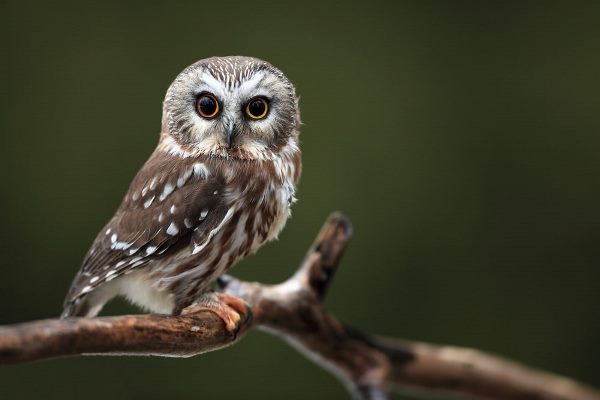
- Scientific name: Aegolius acadicus
- Size: 7.1-8.3 inches long
- Weight: 2.5-5.3 ounces
- Wingspan: 16.5-19 inches
Northern saw-whet owls are petite, about the size of a robin, with a mottled brown and white body. They have big yellow eyes and a heart-shaped face with a small, white V-mark between their eyes.
They are difficult to see, especially because they hunt at night, but if you listen for their shrill call, you’ll know they’re nearby. During the day, they nest in cavities in trees at about eye height, so you might see them if you look carefully. Don’t disturb the sleeping birds, though!
They only live in forests, particularly mature forests, so don’t look for them in open areas or cities. They migrate long distances to breed. They eat small rodents like mice and shrews. They’ll also eat birds like chickadees, juncos, waxwings, and sparrows.
They live across the US, with scarce breeding populations in the South and permanent populations in the northern part of the country and throughout the Rocky Mountains and western Coastal ranges. Nonbreeding populations exist across the rest of the country.
The northern saw-whet owl lives in the northeastern part of Arizona year-round and makes its way down to the southwestern part of the state during the nonbreeding season.
3. Barn Owl

- Scientific name: Tyto alba
- Size: 12.5-16 inches long
- Weight: 14-24.7 ounces
- Wingspan: 40-50 inches
The barn owl got its name because it likes to live in abandoned barns and other buildings in rural areas. They’ll also nest in the cavities of trees. They hunt by soaring across open areas and listening for prey. As you might guess, they have excellent hearing.
You can tell it’s a barn owl by its distinct face. They have pure white, heart-shaped faces with large, dark eyes. Their wings and back are gray, golden, or cinnamon and somewhat mottled. The undersides of their wings are white, as is their chest, which means they look all-white from underneath when they’re flying. They don’t have any ear tufts as the great horned owl does.
Young barn owls will fly far away from where they were hatched to find their own territory, but once they find a spot they like, they stay there for life.
You can find barn owls across the US and Mexico except in a few parts of the central northern states like Montana and North Dakota. The owl lives in every part of Arizona.
4. Western Screech Owl
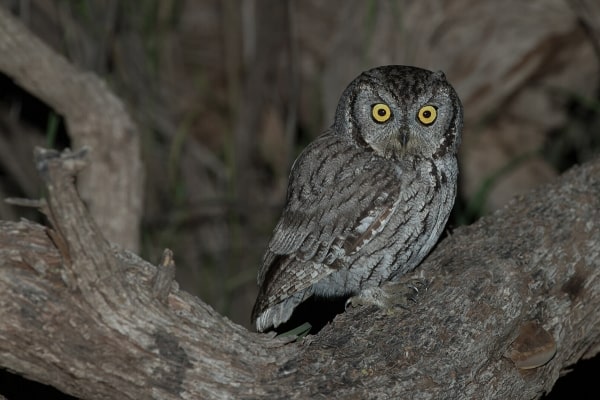
- Scientific name: Otus kennicottii
- Size: 7.5-10 inches long
- Weight: 3.5-11 ounces
- Wingspan: 21.5-24.5 inches
Western screech owls are small, about the size of a robin. But the screech they emit is anything but petite. They’re difficult to find in the wild because they blend in super well with their environment. If you want to find a screech owl, sit outside at night and listen patiently for their distinctive screeches.
The base of their body is gray, brown, or red, with a pale breast. Their body is covered in dark streaks that look incredibly similar to the bark of many trees. They have yellow eyes and distinct ear tufts in a V-shape.
They’re nocturnal, and they make their home in the holes of trees and cacti, but they’ll also make their home in a nestbox in your backyard if you provide them with one. They’re common in suburban areas, and they’ll even make their home in urban parks. In Arizona, these petite owls live everywhere.
While they prefer to eat small rodents, they’re powerful birds and can even pick up a full-grown rabbit.
5. Northern Pygmy-Owl

- Scientific name: Glaucidium gnoma
- Size: 6.3-7.1 inches long
- Weight: 2.2-2.5 ounces
- Wingspan: 12 inches
As you might guess from the name, this is a tiny owl. They’re brown overall with small white spots on their head and more prominent white spots on their wings and back. On the back of their neck, they have two spots that resemble eyes to scare away other predators like Great Horned Owls.
They live in forests and nest in conifers, which is why they’re prevalent in the Pacific Northwest and in much of the Rocky Mountains. Those bird hunting in Arizona can find this petite owl in the eastern part of the state.
They don’t migrate but stay in the same area for their entire lives. They will move to lower elevations during the coldest time of the year.
Like many other owls, they nest in cavities in trees. They don’t make the hole themselves, though. They look for holes left by other animals or natural decay.
Northern pygmy owls eat small birds, lizards, insects, and mammals, but they might even snag a larger bird like a quail. They hunt during the day.
6. Ferruginous Pygmy Owl
- Scientific name: Glaucidium brasilianum
- Size: 6.5 inches long
- Weight: 2.5 ounces
- Wingspan: 14.5-16.0 inches
The Ferruginous pygmy owl is a beautiful reddish-brown bird with a striped tail, mottled gray or white chest, bright yellow eyes, a round head, and black “eyebrows.”
Depending on the kind of prey they’re hunting and the weather, these owls may hunt in the early morning, daytime, or late evening. They eat lizards, insects, and small mammals. When it’s hunting, small burds will often mob in order to drive it away.
This tiny owl doesn’t live in many areas outside of Mexico, Central and South America, where it is common. But you can find a few colonies of Ferruginous pygmy owls in a few parts of Arizona and southern Texas in semi-woodland open habitats.
It used to be considered endangered in some areas, but is now considered stable.
7. Burrowing Owl
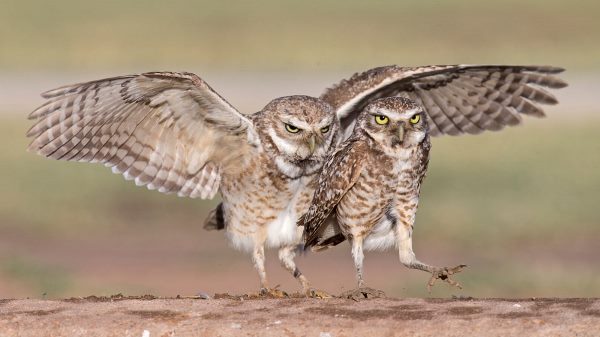
- Scientific name: Athene cunicularia
- Size: 7.5-9.8inches long
- Weight: 5.3 ounces
- Wingspan: 21.5 inches
Most owls live in the trees or shrubs, but burrowing owls have long legs to run along the ground in prairies, deserts, and grasslands. They hunt for rodents and then live in tunnels that animals have abandoned like ground squirrels and prairie dogs.
They’ll even hunt small rodents and then take over their burrows. If that’s not available, they’ll live in pipes or tubing.
They’ve adapted to life underground by developing a high tolerance for carbon dioxide, which builds up in underground spaces.
Look for long-legged owls with mottled brown coloring and bright yellow eyes to identify them. They have flat heads.
Burrowing owls breed in the northern half of Arizona and live year-round in the southern part of the state.
8. Flammulated Owl

- Scientific name: Psiloscops flammeolus
- Size: 5.9-6.7inches long
- Weight: 1.5-2.2 ounces
- Wingspan: 15.9-16.1 inches
The Flammulated owl is tiny. It’s barely larger than a sparrow. These are night-hunting owls that roost in trees during the day. At night, they swoop out to spot their insect prey and devour it.
They live in coniferous forests in the western part of the US. You can find them in a few areas in the central and northern parts of Arizona. They spend their time year-round in Mexico.
For such a tiny bird, you might mistake them for something much, much larger if you were to only hear their call. They have a deep, booming hoot that makes them sound large. This helps them scare away other predators.
Look for a tiny owl with feathered ear tufts and vertical stripes on the belly. They have dark eyes and a grayish back.
9. Spotted Owl
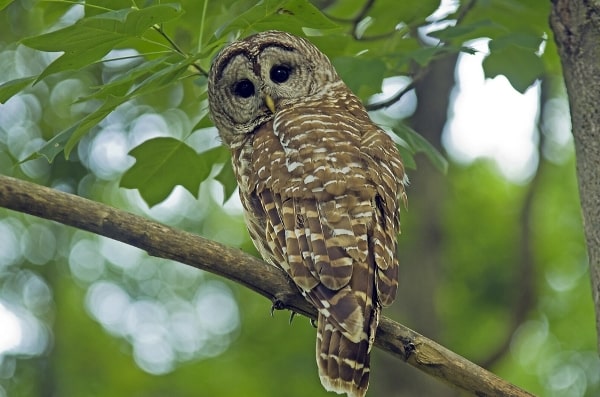
- Scientific name: Strix occidentalis
- Size: 18.5-19 inches long
- Weight: 17.6-24.7 ounces
- Wingspan: 40 inches
As the name suggests, spotted owls have white spots, but they look dark brown overall. You’ll see more white spotting on the chest and less on the back and wings. They have distinct dark brown facial disks with a white “X” between the brown eyes.
These nocturnal birds hunt for small mammals like rats and squirrels. They’re silent hunters, and once they find their prey, they fly down and snatch them up. They live and hunt in mature forests, but since many are being cut down, the spotted owl population is in decline.
This bird is federally protected, but logging, habitat loss, and competition from Barred Owls are driving down populations.
Count yourself lucky if you’re able to spot one. They’re rare. Go out at night and listen for their hooting to have a chance at finding one.
There are three subspecies, which include the Northern Spotted Owl, the California Spotted Owl, and the Mexican Spotted Owl. In Arizona, you’ll see the Mexican Spotted Owl in small flocks across the state.
10. Elf Owl

- Scientific name: Micrathene whitneyi
- Size: 4.7-5.5 inches long
- Weight: 1.2-1.9 ounces
- Wingspan: 13.0 inches
Say “hello” to the smallest raptor in the entire world. These desert-loving owls live in the south part of Arizona during the breeding season. The rest of the time, you can find them in Mexico.
They’re smaller than a robin and use their size to their advantage, taking over small cavities in trees left by woodpeckers and other critters. They hunt at night, looking for insects to eat.
While they’re easily recognized by their puppy-like calls, if you happen to see one, you can probably identify it just by its size. Also look for the round head that lacks ear tufts, the big yellow eyes, and white eyebrow-like markings. Their bodies are mottled gray, brown, and white.
11. Whiskered Screech Owl
- Scientific name: Megascops trichopsis
- Size: 6.3-7.9 inches long
- Weight: 2.4-4.2 ounces
- Wingspan: 17.3 inches
The whiskered screech owl can be either primarily brown with red or with gray, with white mottling. They have a round head, big yellow eyes, and small ear tufts. It makes a screeching sound as it hunts, but it also has a more subtle “boo” call.
They’re related to the western screen owl, but you typically find them in higher elevations than their cousin. This is the most rare of the three screech owls. You can find them out hunting at night for insects and sleeping in the cavity of trees during the day.
This owl is common in Mexico, but not in the rest of North America. However, you can find it in the bottom southeast corner of the state.
12. Long-Eared Owl
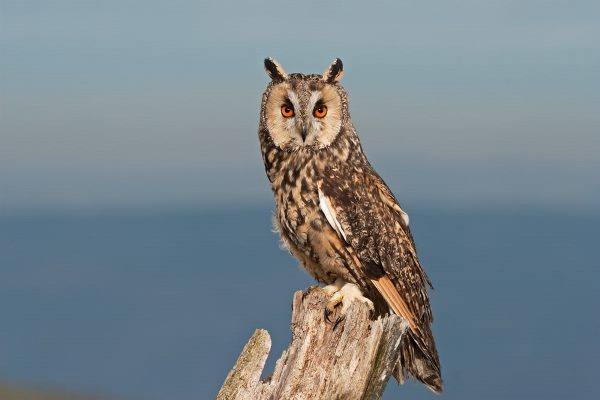
- Scientific name: Asio otus
- Size: 13.8-15.8 inches long
- Weight: 7.8-15.3 ounces
- Wingspan: 35.5-39.5 inches
Long-eared owls have surprisingly long ear tufts, which is how they got their name. The tufts are black with bits of buff or orange. They have two white lines between their yellow eyes.
They’re slender with mottled brown bodies. These nocturnal birds roots in trees and hunt in grasslands or open country.
You can often identify them by their hoots, squeals, and barks. They are quite vocal. They usually only migrate at night, but they can fly exceptionally long distances. Researchers have identified birds that have traveled from Canada to Mexico in a single year.
Those who live in or are visiting Arizona should look for this bird year-round in most of the state except for the southwestern edge, where they only appear during the nonbreeding season.
13. Short-Eared Owl

- Scientific name: Asio flammeus
- Size: 13.4-17 inches long
- Weight: 7.3-16.9 ounces
- Wingspan: 33.5-40.5 inches
You’re right if you guessed that these owls have short ear tufts. Owls have ear tufts to help direct sound to their ears, enabling them to hunt and hear potential predators. Short-eared owls have ear tufts, but they’re small, like little horns.
They’re distinctive owls because they have brown and white mottling edged in black bars. The face is cream with dark black outlines around the yellow eyes.
Their distinctive appearance makes it easier to spot them, but the fact that they are active during the day makes it even easier to see them. They even have a distinct, moth-like flight pattern that makes identification even simpler.
Unlike many owls, they don’t prefer wooded areas. They like open fields and grasslands, where they sit on the ground and watch and listen for prey to catch. Then, they fly up and dive down to catch their prey. They even nest in the ground.
These owls live in Arizona during the nonbreeding season.
Also Read: Woodpeckers in Arizona
